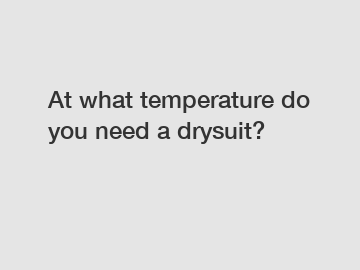At what temperature do you need a drysuit?
Choosing the Right Gear: At What Temperature Do You Need a Drysuit?
Sailing, diving, kayaking, and rowing are all water sports that require appropriate gear for optimal performance and safety. One critical piece of equipment for cold-water activities is a drysuit. But at what temperature do you really need a drysuit? Understanding the conditions under which a drysuit is necessary can help you make informed decisions about your gear choices. .
**What is a Drysuit?**.

A drysuit is a full-body garment designed to provide insulation and keep the wearer dry in cold water. Unlike wetsuits, which allow a thin layer of water to enter and then warm up against the body, drysuits are watertight and prevent water from seeping in. They are typically made from waterproof materials like neoprene or breathable fabrics with a waterproof membrane. Drysuits are worn over regular clothing and are sealed at the wrists and neck to keep water out.
**Factors to Consider**.
Several factors influence the decision of whether to wear a drysuit for cold-water activities. These factors include water temperature, air temperature, wind chill, personal tolerance to cold, duration of exposure, and the intensity of the activity. .
**Water Temperature**.
One of the key factors in determining the need for a drysuit is water temperature. Generally, drysuits are recommended when water temperatures are below 60 degrees Fahrenheit (15 degrees Celsius). At these temperatures, the risk of hypothermia increases significantly, and wearing a drysuit can help regulate body temperature and prevent heat loss.
**Air Temperature and Wind Chill**.
In addition to water temperature, air temperature and wind chill also play a role in deciding whether to wear a drysuit. Even if the water temperature is above 60 degrees Fahrenheit, cold air and wind can still cause rapid heat loss from the body. In these conditions, a drysuit can provide an extra layer of protection against the elements.
**Personal Tolerance to Cold**.
Individual tolerance to cold varies, so what feels comfortable for one person may be too cold for another. It's essential to know your own limits and wear appropriate gear to stay safe and comfortable in cold-water environments. If you tend to get cold easily, wearing a drysuit can help you stay warm and enjoy your water activities more.
**Duration of Exposure and Activity Intensity**.
The length of time you plan to spend in the water and the intensity of your activity also influence the need for a drysuit. If you'll be in the water for an extended period or engaging in vigorous activities that generate heat, a drysuit can help you maintain a comfortable body temperature. For shorter exposures or less intense activities, a wetsuit or other thermal clothing may be sufficient.
**Conclusion**.
In conclusion, deciding at what temperature you need a drysuit depends on a combination of factors, including water temperature, air temperature, wind chill, personal tolerance to cold, duration of exposure, and activity intensity. As a general guideline, drysuits are recommended for water temperatures below 60 degrees Fahrenheit to prevent hypothermia and ensure your safety and comfort in cold-water environments. Understanding these factors and choosing the right gear for your specific needs can help you make the most of your cold-water activities.
If you have any questions about choosing the right gear for your next water adventure or need assistance with selecting a drysuit, please do not hesitate to contact us. We are here to help you stay safe and enjoy your time on the water.
If you are looking for more details, kindly visit wetsuit wholesale, custom scuba wetsuits, wholesale wetsuits.
24
0
0

Comments
All Comments (0)